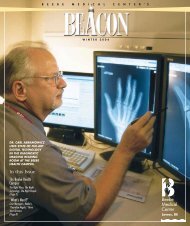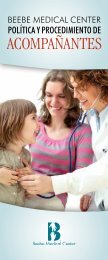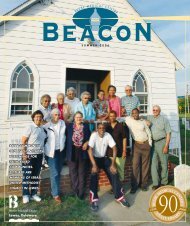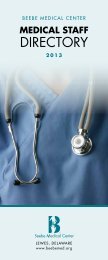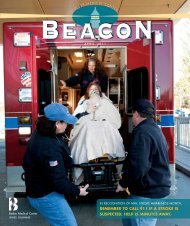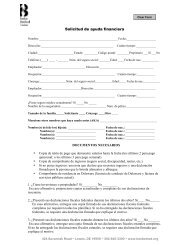Beacon-Summer 2005 - Beebe Medical Center
Beacon-Summer 2005 - Beebe Medical Center
Beacon-Summer 2005 - Beebe Medical Center
Create successful ePaper yourself
Turn your PDF publications into a flip-book with our unique Google optimized e-Paper software.
B E E B E M E D I C A L C E N T E R ’ S<br />
PROFESSIONAL<br />
AMERICAN SIGN<br />
LANGUAGE INTERPRETER<br />
PATTY SHORT-DYES<br />
FACILITATES COMMUNI-<br />
CATION BETWEEN<br />
DR. ERCILIA ARIAS<br />
SUMMER <strong>2005</strong><br />
AND DEAF PATIENT<br />
GILBERT EASTMAN<br />
In this Issue:<br />
United Souls<br />
<strong>Beebe</strong> Focuses on Meeting the<br />
Needs of a Diverse Community<br />
(Page 2)<br />
Expansion<br />
Emergency Department to Double<br />
in Size By 2007<br />
(Page 6)<br />
Prostate Cancer<br />
Why Do African-American Men Face<br />
the Greatest Risk<br />
(Page 10)<br />
Lewes, Delaware
UNITEDSouls<br />
<strong>Beebe</strong> Focuses on<br />
Meeting the Needs of<br />
a Diverse Community<br />
<strong>Beebe</strong>’s Diversity Committee is comprised of <strong>Beebe</strong> employees and individuals from the community.<br />
Their task is to bring awareness and understanding of diversity to the <strong>Beebe</strong> family of employees.<br />
In 1998, when Gilbert Eastman, a retired Gallaudet<br />
University professor, moved to Bethany Beach from<br />
Annapolis, he wanted to make sure that he, as well<br />
as others in the deaf community, could communicate<br />
with doctors, nurses, and other medical staff when<br />
visiting <strong>Beebe</strong> <strong>Medical</strong> <strong>Center</strong>.<br />
He had learned from a newspaper article that<br />
<strong>Beebe</strong> had organized a signing class for employees,<br />
but that the instructor was not deaf. Dr. Eastman, who<br />
was presented with an honorary doctor of fine arts<br />
degree in 2002 from<br />
Gallaudet, a recognized<br />
university for the deaf,<br />
believed that the class<br />
would learn more from a<br />
recognized deaf educator.<br />
He wrote a letter to <strong>Beebe</strong><br />
expressing his concern,<br />
hoping that he could<br />
help <strong>Beebe</strong> doctors and<br />
employees better understand<br />
their deaf patients.<br />
“I have become aware that<br />
there is quite a growing<br />
population of deaf people<br />
Ellen Tolbert, Director of Patient<br />
in the area, which is part<br />
Relations, was instrumental in<br />
helping Dr. Eastman by providing<br />
access to a professional interpreter.<br />
2
Gilbert Eastman, of Bethany Beach,<br />
is deaf. Using sign language, professional<br />
interpreter Patty Short-<br />
Dyes interprets both Dr. Eastman’s<br />
and his healthcare provider’s communications<br />
clearly and accurately.<br />
of the reason for my letter,” he wrote.<br />
<strong>Beebe</strong>’s Patient Relations Director, Ellen Tolbert,<br />
not only listened to Dr. Eastman, but also invited him<br />
to share his knowledge of the growing deaf community<br />
that was retiring to coastal Delaware from nearby<br />
metropolitan areas.<br />
Several employees participated in two classes<br />
through Delaware Tech that did not qualify them to be<br />
interpreters, but did teach them skills for basic communication<br />
until an interpreter can arrive. <strong>Beebe</strong> has<br />
contracts with four professional interpreters certified<br />
in American Sign Language.<br />
Other features the hospital uses to serve the<br />
deaf population include technology that enables deaf<br />
patients to use the telephone and to contact off-site<br />
interpreters when necessary. This equipment can be<br />
hooked up in any hospital room. Television sets are<br />
closed-captioned. Laptops are available. Signs are<br />
posted above deaf patients’ beds so that even after a<br />
shift change, hospital employees know that the patient<br />
cannot hear. And education programs are under way<br />
to help hospital staff understand the unique needs of<br />
the deaf.<br />
“I really appreciate what <strong>Beebe</strong> has done,”<br />
Dr. Eastman recently said through professional interpreter<br />
Patty Short-Dyes. He<br />
emphasized the need for a<br />
certified interpreter when<br />
there are serious medical<br />
issues.“I was in the hospital<br />
last year and the services<br />
were wonderful,” he said.<br />
“Patty was with me for certain procedures that to<br />
have tried to write back and forth with the doctor<br />
“I was in the hospital last<br />
year and the services were<br />
wonderful.” —Gilbert Eastman, Ph.D.<br />
3
“Our team developed a<br />
diversity manual tailored for<br />
<strong>Beebe</strong> and its patient base.”<br />
—Lynn Amey, chair of <strong>Beebe</strong>’s diversity committee<br />
and director of cardiovascular services.<br />
would have been all but impossible.”<br />
<strong>Beebe</strong>’s effort to better serve the area’s growing<br />
deaf community represents one aspect of the <strong>Medical</strong><br />
<strong>Center</strong>’s focus on serving a diverse population. Several<br />
years ago, the hospital formed a Diversity Committee to<br />
study the area’s changing<br />
demographics. An obvious<br />
change was the growth in<br />
the Hispanic community,<br />
which had more than<br />
tripled in Sussex County<br />
between 1990 and 2000.<br />
In nearby Georgetown,<br />
for example, during the<br />
same time frame, the documented Hispanic population<br />
had grown from 2 percent to 32 percent of the total<br />
population. <strong>Beebe</strong> doctors and employees already<br />
were experiencing patients coming to the Emergency<br />
Department in need of critical care, but with no English<br />
language skills.<br />
Research also showed<br />
<strong>Beebe</strong> that there were<br />
growing Korean and Haitian<br />
populations in Sussex<br />
County, and that African-<br />
Americans,American<br />
Indians, and the gay, lesbian,<br />
bi-sexual, and transgender<br />
(GLBT) community had<br />
unique and unmet needs.<br />
Obese patients also had<br />
specific needs that were<br />
not being addressed.<br />
Ellen Tolbert says that<br />
the committee garnered<br />
information from the<br />
American Hospital<br />
Association and the Society<br />
for Health Care Consumer<br />
Alina Ferrer, Spanish interpreter in the Patient Relations Department,<br />
translates for the Hispanic community.<br />
Advocates, two organizations that also were studying<br />
the nation’s changing demographics and healthcare<br />
disparities. <strong>Beebe</strong> also elicited opinions from experts<br />
in the local community.<br />
“We looked at diversity in the broadest terms,”<br />
says Lynn Amey, Director of Cardiovascular Services<br />
Mr. Richard Merriwether (above), a U.S. Defense Department retiree now living in Rehoboth Beach, serves as<br />
Co-Chairman of the Minority Outreach Committee with Mr. Noble Prettyman.<br />
4
and Chairperson of <strong>Beebe</strong>’s Diversity Committee.<br />
“Our team developed a diversity manual tailored for<br />
<strong>Beebe</strong> and its patient base.”<br />
So far, the result is a diversity program with a<br />
resource manual that focuses on the Hispanic culture,<br />
the African-American culture, the American Indian<br />
culture, sexual minorities, and body size. The manual<br />
is used in an ongoing employee education process.<br />
Diversity awareness has allowed <strong>Beebe</strong> to better<br />
understand its patients and improve its services.<br />
In regards to the growth in the Hispanic population,<br />
<strong>Beebe</strong> hired its first full-time, certified Spanish interpreter,<br />
Alina Ferrer. A language bank made up of more<br />
than 20 employees and three volunteers who speak<br />
different languages was prepared and distributed to<br />
all departments. More than a dozen speak Spanish;<br />
the others speak German, Japanese, Korean, Lithuanian,<br />
and Polish.<br />
Statistics show that the African-American population,<br />
on average, was not getting cancer screenings<br />
done in time to catch the disease in its early stages.<br />
<strong>Beebe</strong>’s own numbers at the Tunnell Cancer <strong>Center</strong><br />
indicate that 32 percent of African-American patients<br />
begin treatment in the later stages of cancer, while<br />
only 10 percent of white patients begin treatment at<br />
later stages. Conversely, about 47 percent of white<br />
patients are seen at stage one, where treatment is most<br />
beneficial, compared to only 29 percent of African-<br />
Americans.<br />
Last year, to increase these numbers, <strong>Beebe</strong> created<br />
a Minority Outreach Committee focused on improving<br />
overall health and life expectancies. This summer, some<br />
committee members visited South Bend Memorial<br />
Hospital in Indiana, an institution known for its community<br />
outreach efforts. The group wanted to learn<br />
about efforts that also may benefit communities surrounding<br />
<strong>Beebe</strong>.<br />
<strong>Beebe</strong> research also has shown that another<br />
one of its growing patient bases is what the manual<br />
describes as “sexual minorities,” or “. . . those who are<br />
not exclusively heterosexual.” One way the <strong>Medical</strong><br />
<strong>Center</strong> is meeting the needs of this community is<br />
to bring health education, screenings, and referral<br />
efforts to Camp Rehoboth, an organization focused<br />
on helping the GLBT community.<br />
Odette Wright, a religious leader with the<br />
Nanticoke Indian tribe, who teaches courses to <strong>Beebe</strong><br />
staff on the Nanticoke culture, believes that if there<br />
is understanding, there is respect—and with respect,<br />
people can come together to find solutions. ■<br />
Odette Wright, a member of the Nanticoke Indian tribe, helps <strong>Beebe</strong> bring comfort to American Indian patients.<br />
5
EMERGENCY DEPARTMENT TO DOUBLE IN SIZE BY 2007<br />
<strong>Beebe</strong> <strong>Medical</strong> <strong>Center</strong>’s Emergency Department <strong>Medical</strong> Director, Dr. Michael<br />
Edwards, is in an optimistic mood these days.<br />
Despite some disruption that the ongoing construction around <strong>Beebe</strong> <strong>Medical</strong><br />
<strong>Center</strong> might be causing now and throughout the next year, he knows that the end<br />
result will be an Emergency Department twice its present size, as well as more beds<br />
and services in an enlarged medical center—all to meet the healthcare needs of<br />
a booming population base.“It excites me,” he says.“Not only will there be twice<br />
as many beds in the Emergency Department, and additional trauma space, but the<br />
overall project that is bringing more inpatient beds means that we will be able to<br />
expand our services and have the opportunity to sub-specialize.”<br />
Sub-specializations in the Emergency Department will include a dedicated area<br />
for pediatrics, a dedicated area for psychiatric patients who also may be suffering<br />
from drug or alcohol abuse, and more space, and time, for short-term observations.<br />
E. James Monihan, Special Consultant to the President, and Chief Operating<br />
Officer Rick Schaffner supervise the Emergency Department expansion<br />
project at <strong>Beebe</strong>.<br />
6
Emergency Department nurse Christine<br />
Medd checks a patient’s status on the<br />
triage monitor. Dr. Michael Edwards is<br />
in the foreground.<br />
“We can keep patients longer under observation<br />
before either sending them home or admitting them<br />
into the hospital,” he says.<br />
The department will have more space to dedicate<br />
to those who need time-consuming acute care,<br />
as well as to those whose conditions are less acute<br />
and can be handled in a timely manner. This ability<br />
to separate patient services will improve waiting time,<br />
he predicts. Dr. Edwards, who has been tracking the<br />
growth in the number of patient visits, says that from<br />
2000 to 2004 the number has grown from 27,000 to<br />
33,600, nearly a 25 percent increase in five years.<br />
Today’s Emergency Department is just about at<br />
capacity, he says, but the increase in patient visits<br />
is not expected to slow. By the end of this year,<br />
Dr. Edwards estimates, about 36,000 patients will visit<br />
the Emergency Department—a 7 percent increase<br />
from 2004. As part of the expansion, the department<br />
will receive additional wireless computers to operate<br />
the ibex PulseCheck® electronic system. This system<br />
tracks every patient and all the medications and<br />
services they receive while in the department.<br />
Dr. Edwards says he is also looking forward to having<br />
a conference room for staff meetings, educational<br />
programs, and discussions about special needs patients.<br />
“Conference space is at a premium in the hospital, and<br />
it is something that we really need.”<br />
The construction project, estimated to cost $35 million,<br />
began in the spring and should be completed in<br />
From 2000 to 2004, the annual number of patient visits to the Emergency Department increased by 25 percent, and visits<br />
continue to climb in <strong>2005</strong>.<br />
7
When walk-in Emergency Department patients arrive, they check in at the<br />
new information desk (above) just inside the entrance. Pictured are switchboard<br />
operator Betty O. Creadick and auxiliary member Wendell Alfred.<br />
Improvements have been made in the Emergency Department waiting area<br />
(right) to increase patient comfort.<br />
2007. It includes expanding the Emergency<br />
Department from 18 to 36 beds, expanding the<br />
Critical Care Unit from 12 to 20 beds, and adding<br />
a 42-bed <strong>Medical</strong>-Surgical Unit above the Critical Care<br />
Unit. In all, the project—including combined renovations<br />
and new construction—will total 87,000 sq. feet<br />
and will enable <strong>Beebe</strong> to develop an interventional<br />
cardiology and heart surgery program. The project not<br />
only includes the construction of a building, but also<br />
the addition of nearly $7 million in healthcare equipment<br />
that will upgrade medical-imaging services and<br />
improve overall patient-care technology.<br />
Due to careful planning on the part of <strong>Medical</strong><br />
<strong>Center</strong> leaders, there will be few, if any, disruptions<br />
that will affect healthcare services.<br />
E. James Monihan, a former <strong>Beebe</strong> vice president<br />
who has been associated with the <strong>Medical</strong> <strong>Center</strong> for<br />
43 years, says the construction project is one of the<br />
largest undertaken by <strong>Beebe</strong> in its 89-year history.<br />
Monihan is overseeing the $35 million project in<br />
his capacity as Special Consultant to <strong>Beebe</strong> President<br />
Jeffrey Fried.<br />
“The big influx in population growth is definitely<br />
driving our growth,” he says.“If you look at all the<br />
projects on and off site, we’re working everywhere.<br />
We’re improving access to healthcare for our growing<br />
community.”<br />
Monihan stresses that over the years <strong>Beebe</strong> has<br />
always been ahead of the curve in its plans to meet<br />
the healthcare needs of the community. ■<br />
Patients and visitors who come to the hospital for non-emergencies are encouraged to enter the West<br />
Entrance and park in the garage located behind the hospital. Patients and visitors who come to the<br />
Emergency Department may still enter the East Entrance and use the Emergency Department parking.<br />
Emergency Department patients should use the East Entrance (above); all other<br />
visitors and patients are encouraged to use the West Entrance and park in the<br />
garage located behind the hospital.<br />
8
<strong>Beebe</strong> <strong>Medical</strong> <strong>Center</strong><br />
CAPITAL PROJECTS 2003–2007<br />
COMPLETED<br />
2003: OUTPATIENT CARE CENTER opens at the<br />
<strong>Beebe</strong> Health Campus. Offers diagnostic<br />
imaging, physical therapy, and express<br />
lab/EKG testing. September <strong>2005</strong> marks<br />
the facility’s second anniversary.<br />
2003: CENTRAL UTILITY BUILDING completed.<br />
Houses new electrical, heating, and cooling<br />
systems to accommodate the hospital’s<br />
increased utility needs.<br />
COMING SOON<br />
2006: TUNNELL CANCER CENTER will be constructed<br />
at the <strong>Beebe</strong> Health Campus offering<br />
a new, convenient location for medical<br />
and radiation oncology.<br />
2006: INTERVENTIONAL CARDIOLOGY AND<br />
HEART SURGERY PROGRAM will be available<br />
so Sussex County residents can receive<br />
these services locally. <strong>Beebe</strong> <strong>Medical</strong> <strong>Center</strong><br />
has an affiliation agreement for heart<br />
surgery with Christiana Care Heath System,<br />
Delaware’s most experienced leader in<br />
heart surgery.<br />
2006/2007: MILLVILLE services will expand to<br />
include MRI, CT, and ultrasound.<br />
2007: EMERGENCY DEPARTMENT will double in<br />
size, increasing from 18 to 36 beds.<br />
2004: BEEBE MEDICAL CENTER enters into a partnership<br />
with a group of affiliated physicians<br />
to open the Southern Delaware Surgery<br />
<strong>Center</strong> at the <strong>Beebe</strong> Health Campus. The<br />
surgery center provides a convenient location<br />
for outpatient surgery with plenty of parking.<br />
2007: CRITICAL CARE UNIT will be relocated to<br />
the Rollins Building and will expand from<br />
12 to 20 beds.<br />
2007: An additional 42 MEDICAL/SURGICAL<br />
BEDS will be available directly above the<br />
new Critical Care Unit.<br />
9
PROSTATE CANCER<br />
PROSTATE CANCER<br />
WHY DO AFRICAN-AMERICAN MEN FACE THE GREATEST RISK<br />
Prostate cancer is a common cancer that can<br />
be cured with an early diagnosis, yet can be deadly<br />
when found too late.<br />
Because of this risk, adult men should have regular<br />
screening tests so that the cancer can be detected in<br />
its early stages. And while statistics show that there is<br />
an increase in the number of screenings, as well as in<br />
the successes of early treatment, a most discouraging<br />
statistic remains.<br />
African-American men, possibly due to genetics,<br />
are more likely to get prostate cancer, less likely to get<br />
tested, and more likely to die as a result. In fact,African-<br />
American men have the highest incidence and mortality<br />
rate of prostate cancer in the world, according to a<br />
study by Florida International University that was published<br />
in a 2004 edition of the Journal of the National<br />
<strong>Medical</strong> Association.<br />
An African-American man has:<br />
• a 19% chance (1 in 5) of being diagnosed with<br />
prostate cancer; and<br />
• a 5% chance (1 in 20) of dying from prostate<br />
cancer—more than double the death rate of<br />
caucasian men in the United States.<br />
Delaware statistics for African-American men are<br />
worse.While the incidence rate of prostate cancer for<br />
caucasian men in Delaware is about 150 in 100,000,<br />
the rate for African-American men is about 250 in<br />
100,000. The mortality rate for caucasian men is<br />
30 in 100,000. The rate for African-American men<br />
in Delaware is 70 in 100,000—more than double<br />
the rate of caucasian men.<br />
Sussex County<br />
community activist<br />
and African-American<br />
Diaz Bonville, who has<br />
dedicated himself for<br />
more than 20 years<br />
to improving the<br />
health and education<br />
of adults and young<br />
people in the county,<br />
says he would like to<br />
do whatever it takes<br />
to educate African-<br />
American men about<br />
protecting themselves<br />
from prostate cancer.<br />
In the following interview,<br />
he explains why<br />
Diaz Bonville, community activist<br />
he believes African-American men do not get the<br />
screenings and treatments that they need, and what<br />
can be done to motivate them to overcome this lifethreatening<br />
disease.<br />
Q<br />
A<br />
Is there a mindset that may cause African-American<br />
men to avoid getting regular screenings<br />
I believe there is. In general, the average African-<br />
American man thinks about survival first. He thinks<br />
about employment, and providing for his family.<br />
He thinks about his own health last. Now I’m not<br />
talking about every African-American man. But, in<br />
general, there is a different culture here.<br />
10
Diaz Bonville, Sussex County community activist, educates African-American men about the<br />
importance of regular screenings for prostate cancer.<br />
Q<br />
A<br />
Q<br />
A<br />
Some sources in the national arena say that the<br />
lack of available healthcare, or health insurance,<br />
is one reason that these statistics are so staggering.<br />
Do you agree<br />
I think this also is true. I know that many don’t<br />
have health insurance. Many work in jobs that<br />
don’t have health plans, and they can’t afford to<br />
buy their own insurance. Often times, even if they<br />
have health insurance, or qualify for Medicaid, they<br />
can’t take the time off from work to get a screening<br />
because they work hourly and can’t afford to lose<br />
the income. Even if they have insurance, they can’t<br />
afford the co-pay, and don’t want to spend money<br />
on themselves for something that they don’t consider<br />
important.<br />
Discrimination also has been cited in medical<br />
publications as a reason for lack of screenings<br />
and treatment. Do you think that discrimination<br />
and/or mistrust on the part of African-American<br />
men for the establishment also plays a part in<br />
this situation<br />
There’s definitely a mistrust of the establishment,<br />
and what the healthcare establishment says and<br />
does. The African-American has suffered discrimination.<br />
Many people are still alive who can tell you<br />
some very sad and painful stories. It isn’t as bad<br />
today as it was in the past. There has been a lot of<br />
progress, but there is room to improve. Some African-<br />
Americans still feel as if they are not treated the<br />
same as other people are treated, whether in the<br />
Q<br />
A<br />
healthcare environment or in any other. I believe<br />
that the bottom line, though, when it comes to<br />
cancer, is that we are talking about the difference<br />
between living and dying.We have to move forward.<br />
Men have to realize that they have to attend to their<br />
health—that if they don’t, they will die.<br />
What can we do to increase the awareness of<br />
African-American men in order to cut these high<br />
prostate cancer mortality rates<br />
We need leaders in the African-American community<br />
to take this on and to focus on raising awareness.<br />
People just don’t think about it. More of the church<br />
leaders should talk about it. People who go to church<br />
will listen to them. But we also need other community<br />
leaders, too.We need African-American leaders<br />
who are well known to raise the awareness.We need<br />
local doctors and healthcare officials to come to<br />
activities and gatherings in the African-American<br />
community to show their support for the community.<br />
This is something that is going to take a lot of time<br />
and effort and repetition to make a difference. ■<br />
<strong>Beebe</strong> <strong>Medical</strong> <strong>Center</strong> is calling on black<br />
male leaders, like Diaz Bonville, to help<br />
us reach black men age 40 and older<br />
who have not been screened for prostate<br />
cancer in the past year. Call 645-3100,<br />
ext. 5139, for more information.<br />
11
BEEBE MEDICAL CENTER’S<br />
Community News<br />
ADVANCE DIRECTIVES<br />
Available at <strong>Beebe</strong> <strong>Medical</strong> <strong>Center</strong><br />
Information and forms are free as part of community service<br />
<strong>Beebe</strong> <strong>Medical</strong> <strong>Center</strong> has available, free to the public, the legal forms developed by the state<br />
of Delaware that are used to prepare end-of-life instructions and to appoint a healthcare power<br />
of attorney.<br />
These written Advance Health Care Directives, once completed, signed, dated, and witnessed<br />
as required, allow individuals to decide ahead of time what happens in the event that they are<br />
unable to communicate their wishes.<br />
“There is no greater gift than the gift of information,” says Ellen Tolbert, Director of Patient Relations<br />
for <strong>Beebe</strong> <strong>Medical</strong> <strong>Center</strong>. “And we want to remind people that they need to put their wishes<br />
in writing.”<br />
Tolbert believes that, based on the recent influx of telephone calls she has fielded following the<br />
publicity surrounding the Terri Schiavo case, many people have grown seriously concerned about<br />
what would happen if they, too, were unable to make a decision on their own personal healthcare.<br />
In 1990, Congress passed the Patient Self-Determination Act, which requires hospitals, nursing<br />
homes, and others that receive Medicare or Medicaid funding to inform patients about their<br />
rights under state law to make decisions regarding medical care. This includes the right to accept<br />
or refuse medical care, and the right to make advance directives. Although it is a federal right<br />
to have an advance directive, each state has different laws. Delaware’s Advance Directives can<br />
include End of Life Instructions, appointment of a Healthcare Power of Attorney, and options for<br />
organ donation.<br />
“The biggest mistake adults make, no<br />
matter what their age, is that they don’t<br />
need an Advance Directive,” says<br />
Dr. Jeffrey Hawtof, a member of <strong>Beebe</strong>’s<br />
<strong>Medical</strong> Staff.<br />
Dr. Hawtof, whose office is at Long Neck<br />
Family Practice, has been giving seminars<br />
on the subject for six years. He says that<br />
the state has done a good job of creating<br />
a document that each person can use to<br />
express individual wishes. At the same<br />
time, he urges people to consult with their<br />
doctors as they fill out the forms so that<br />
they understand the medical ramifications<br />
of their decisions.<br />
BEEBE MEDICAL CENTER<br />
PHONE DIRECTORY<br />
General Information . . . . . . . 302-645-3300<br />
Baylis Rehabilitation <strong>Center</strong> . .302-645-3235<br />
<strong>Beebe</strong> Imaging &<br />
Lab Express Locations<br />
—Georgetown . . . . . . . . . . . . 302-856-9729<br />
—Lewes (lab only) . . . . . . . . 302-644-9344<br />
—Long Neck (lab only) . . . . . 302-947-1202<br />
—Millsboro . . . . . . . . . . . . . . 302-934-9039<br />
—Millville . . . . . . . . . . . . . . . 302-539-8749<br />
<strong>Beebe</strong> <strong>Medical</strong> Foundation . . . 302-644-2900<br />
<strong>Beebe</strong> Physical Therapy<br />
—Millsboro . . . . . . . . . . . . . .302-934-1500<br />
—Millville . . . . . . . . . . . . . . . 302-539-6404<br />
Emergency Services<br />
—Lewes . . . . . . . . . . . . . . . . 302-645-3289<br />
—Millville (summer only) . . . 302-539-8450<br />
Gull House Adult<br />
Activities <strong>Center</strong> . . . . . . . . . 302-226-2160<br />
Hastings HeartCare <strong>Center</strong> . . 302-645-3258<br />
Cardiac Rehabilitation • EKG<br />
• Stress Testing • Cardiac Catheterization<br />
Home Health Agency . . . . . . . 302-854-5210<br />
Human Resources . . . . . . . . . . 302-645-3336<br />
Integrative Health . . . . . . . . . . 302-645-3528<br />
Lewes Convalescent <strong>Center</strong> . . 302-645-3030<br />
Outpatient Care <strong>Center</strong><br />
<strong>Beebe</strong> Health Campus . . . . 302-645-3010<br />
Diagnostic Imaging • Women’s Imaging<br />
• Express Testing • Physical Therapy<br />
Physician Referral Service . . . 302-645-3332<br />
Pulmonary Service . . . . . . . . . 302-645-3298<br />
School of Nursing . . . . . . . . . . 302-645-3251<br />
Sleep Disorders <strong>Center</strong> . . . . . 302-645-3186<br />
Tunnell Cancer <strong>Center</strong><br />
—<strong>Medical</strong> Oncology . . . . . . . 302-645-3770<br />
—Radiation Oncology . . . . . . 302-645-3775<br />
Vascular Lab . . . . . . . . . . . . . . 302-645-3710<br />
Women’s Health Pavilion . . . . 302-645-3726<br />
Wound Care Services . . . . . . . 302-947-2500<br />
The <strong>Beacon</strong> is published by <strong>Beebe</strong> <strong>Medical</strong><br />
<strong>Center</strong> to present health information to the people<br />
of Sussex County. Health information provided in<br />
the <strong>Beacon</strong> should not be substituted for medical<br />
advice offered by a physician. Please consult your<br />
physician on medical concerns and questions.<br />
Jeffrey M. Fried, President,<br />
jfried@bbmc.org<br />
Wallace E. Hudson,<br />
Vice President, Corporate Affairs,<br />
whudson@bbmc.org<br />
Sharon Harmon, Editor,<br />
sharmon@bbmc.org<br />
Nancy L. Cummings, Editorial Assistant,<br />
ncummings@bbmc.org<br />
Susan Towers, Writer,<br />
stowers@bbmc.org<br />
For more information on the subject, or to<br />
request an Advance Health Care Directives<br />
packet, call <strong>Beebe</strong> <strong>Medical</strong> <strong>Center</strong> Patient<br />
Relations at 645-3547.<br />
John Birdsell, of Rehoboth Beach, fills out an Advance Health Care Directive.<br />
Lewes, Delaware • www.beebemed.org


